Conference Planning Timeline: Step-by-Step Guide for Academic Events
Organizing a successful academic event requires meticulous coordination and a comprehensive conference planning timeline.
Whether it's your first time or you're a seasoned pro, the importance of a detailed planning timeline cannot be overstated. Planning ahead ensures that everything, from funding to engagement, is handled in a timely and effective manner.
This guide offers a clear, structured breakdown of milestones, month by month, to help you avoid last-minute chaos so that your conference unfolds without a hitch.
Here are the milestones to consider. Check out our conference schedule checklist.
12-18 Months: Laying the Foundation
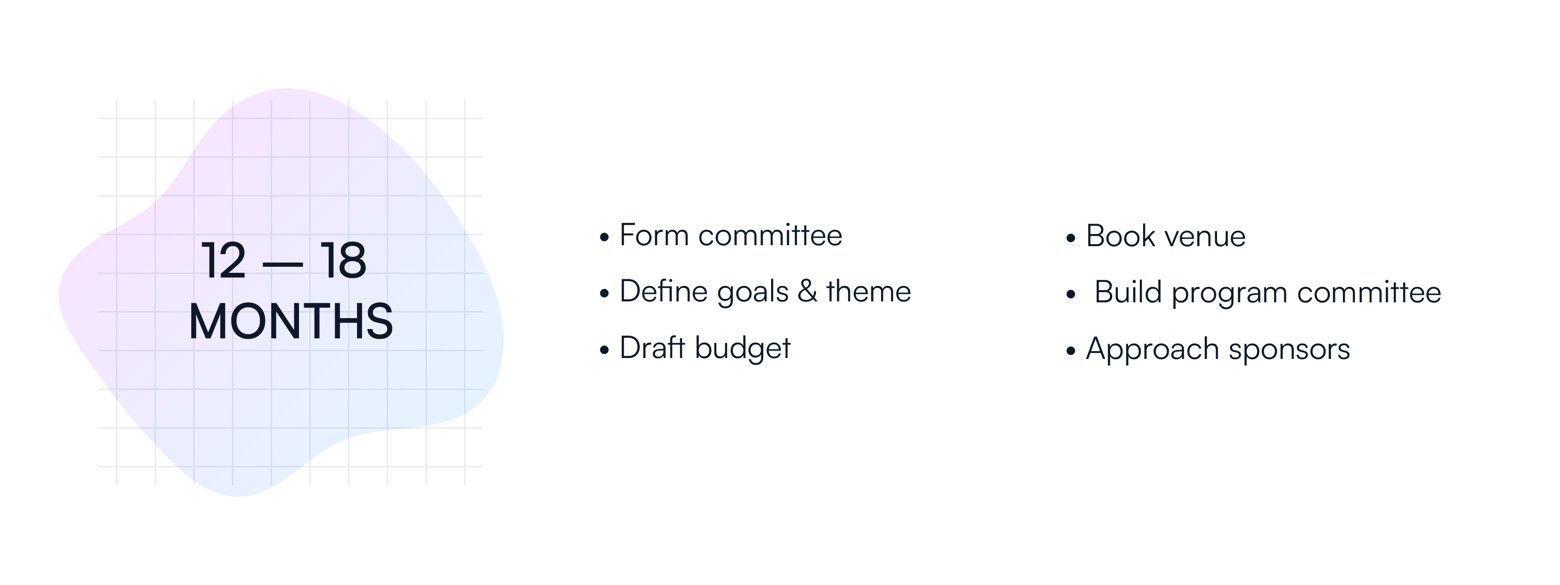
Your academic conference planning timeline should start in advance—at least a year, if not more. By doing so, you are giving yourself and the event planning team ample leeway to prepare.
Assemble the Organizing Committee
Annual academic conferences have the tradition to select the organizing committee at the end of the previous edition. Confirm that all members are on board and assign specific roles to each member.
While organizing an academic conference involves numerous logistical tasks, engaging a Professional Conference Organizer (PCO) can be a game-changer.
A PCO specializes in managing the on-site aspects of the event, from registration and venue coordination to technical support and catering. Their expertise lets you focus on the academic content while they handle all the event management.
PCOs can handle a wide range of responsibilities, including coordinating with the venue, overseeing the setup of conference spaces, and verifying that audiovisual and technical equipment function properly. They can also assist with attendee registration, manage speaker arrangements, and address last-minute changes that may arise during the event. For hybrid or virtual events, a PCO can coordinate the online components; after all, as the event head, you want both in-person and remote attendees to have a stellar experience.
Define the Event Goals, Main Theme and Format
Next your need to define the event goals. They should align closely with the broader objectives of your academic community.
Whether the focus is advancing knowledge in a specific field, fostering collaborations, promoting early career researchers or highlighting the latest innovations, having a clear vision will help steer the direction of the conference.
Identifying your target audience is another critical aspect. Consider who you want to attend—are you targeting students, researchers, or industry professionals? Are you interesting in attracting a local or international audience? Understanding this will help you shape the format and program.
Next, work with your event planning team and subject matter experts to clarify the conference theme. What topics are currently trending? What are the emerging areas of research that require attention? By consulting with peers, including faculty, researchers, and industry experts, you can pinpoint the most relevant and timely topics for discussion.
Next, will the conference be in-person, virtual, or hybrid? This decision will have significant implications for budgeting, logistics, and how the conference is structured. On-site conferences incite face-to-face interactions, while virtual and hybrid formats can increase accessibility for international attendees. Carefully evaluate the benefits and challenges of each format to determine the best fit for your objectives.
Create a Detailed Budget and Funding Strategy
Once the event goals and structure of the conference are in place, develop a detailed budgeting strategy, along with buffers for each item. Start by estimating the various costs associated with hosting the event. Key expenses include the venue, catering, keynote speakers, travel grants for attendees, conference software licensing, and publication fees for proceedings. A comprehensive budget is essential for managing these expenses effectively and keeping expenses in check.
Creating a detailed budget involves more than just tallying up costs; it’s about understanding where funding will come from. At this stage, explore both public and private funding opportunities. Government grants and academic institutions may support conferences that center on explicit research objectives. At the same time, private sponsorships from companies can provide additional financial backing.
Secure the Venue and Confirm Dates
Popular venues are booked early. Make sure to start looking for the perfect location for your conference as early as possible. The venue will require a deposit so getting your budget in line will be important first. When selecting the venue, look at the potential places for social activities, transportation and lodging options. Accessibility should also be top of mind in the venue selection process for people with disabilities.
Securing your venue will also require you to confirm the conference dates. Make sure to look at other popular conferences covering the same topic to ensure you don't overlap too much. Then, confirm with your committee the key dates based on the timeline below.
Form the Conference Program Committee
A well-structured conference program committee is critical to the success of any academic conference. The committee will review abstracts, select papers, and shape the overall conference program. This is a time-consuming but necessary process, as the quality of the selected abstracts will determine the academic integrity and appeal of the event.
When forming your committee, recruit experts with a deep understanding of the field and ideally some experience organizing academic events. They should bring diverse perspectives to the table so that the event’s program is well-rounded and resonates with the target audience. This involves deciding on session topics, organizing the order of presentations, and assigning session chairs who will guide discussions and ensure a smooth flow of the event.
Start Contacting Sponsors
Securing sponsorships is vital for the financial health of your conference. Start by identifying potential sponsors whose interests align with your event's theme and audience. Sometimes, contacting sponsors of the previous editions is a good starting point. Initiate contact early, providing ample time for discussions and negotiations. Building strong relationships with sponsors not only aids in funding but also enhances the credibility and reach of your event.
To attract sponsors, create sponsorship tiers and exhibitor packages. These packages clearly outline the benefits and pricing for sponsors and exhibitors, such as branding opportunities, exhibition space, and speaking slots, to incentivize their participation. It is your responsibility as an event planner to design appealing sponsorship opportunities.
9-12 Months: Building Momentum
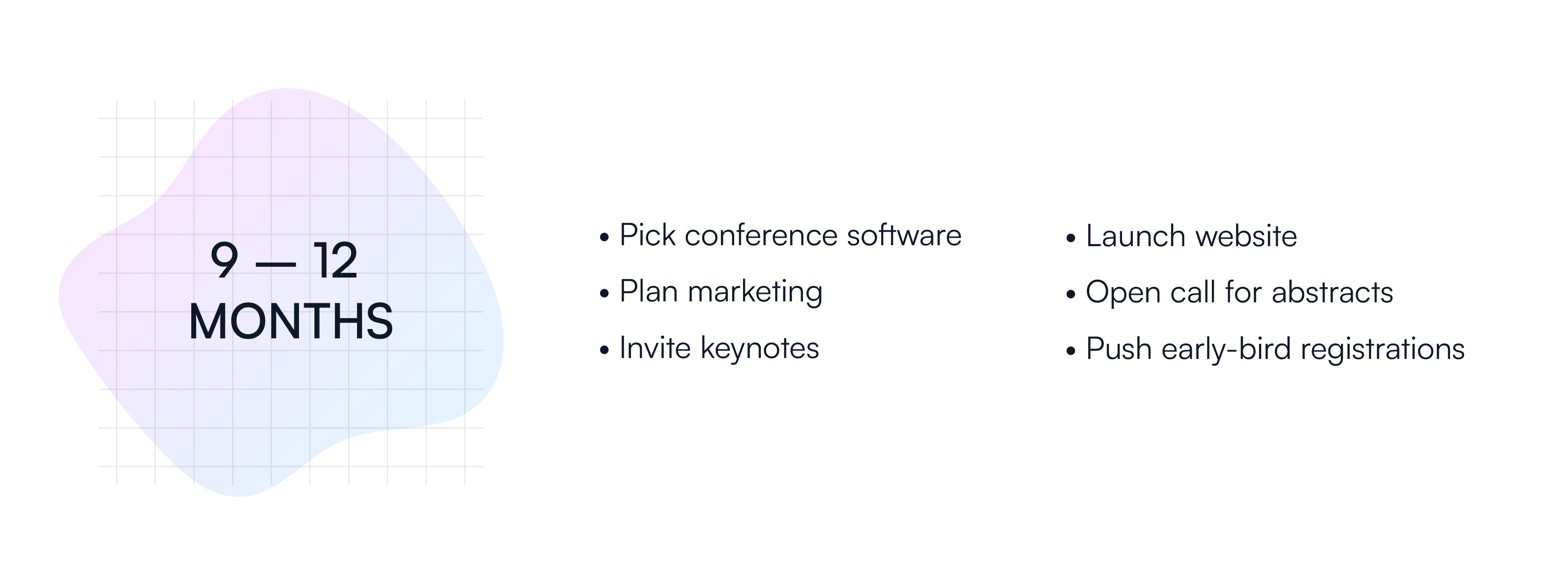
Between 9 and 12 months before the event, your focus should be on actively promoting the conference and gathering submissions as well as early registrations. Let’s explore what typically occurs during these months.
Select your Conference Software
Efficient abstract submission management and attendee registration are required for any academic conference, especially when dealing with a large volume of papers and participants.
Finding the right academic conference abstract management software will streamline the submission process. Look for platforms that allow authors to easily submit their abstracts, upload supporting materials, and track the progress of their submissions. The right software will also help your review committee efficiently evaluate and provide feedback on submissions, which can save valuable time.
A good event registration platform should offer a simple experience for attendees, communication tools for updates and check-in apps. Make sure it can accomodate different registration categories, such as student, faculty, and industry professional rates.
If your conference will include virtual sessions, look for a platform that include or integrates with virtual event solutions. Make sure it's easy for attendees of all technical backgrounds to navigate.
All-in-one solutions that include module for abstract submissions, peer-review, online program, registrations, event website, virtual and on-site apps are the best as they centralize everything and avoid chaos. Avoid trying to save costs when selecting software as it is an important piece that ties everything together and that your team will use daily.
Plan your Promotion Strategy
A strong outreach and promotion strategy will attract attendees and raise awareness of your academic conference. Start by promoting the conference within university departments and research networks to get the word out. This is where much of your target audience is based, so reach out first to faculty members, researchers, and students. Academic journals can help spread the word by featuring your event or sharing it with their readers, giving you access to a broader audience.
Leveraging institutional channels and academic social media platforms is another effective way to promote your conference. These channels are already trusted within academic circles, and you'll generate interest by posting updates, speaker announcements, and other relevant information. Engaging with social media platforms, including X, Bluesky, LinkedIn, and Facebook, can help you reach more people, especially if you use specific event or topic matter hashtags as well as engage with academic communities online.
Invite Keynote Speakers
With your program committee, start contacting speakers that align with your event goals and theme. The sooner you reach out, the more likely you'll get them to accept.
Launch your Conference Website
An academic conference website is an excellent communications tool for potential participants, speakers and sponsors. It should clearly feature all the conference’s details, like the save the date, registration information, and submission guidelines. This information should be easily accessible so attendees can quickly find what they need to make their plans as easily as possible.
Launch a simplified version early to create a buzz around your event and start attracting sponsors. Add more information on the website as details get confirmed. Make sure to communicate the key dates like when early registration starts and when submissions open.
Launch your Call for Abstracts
Opening the call for abstracts is a pivotal moment in your conference planning timeline. Set clear deadlines for both abstract and full paper submissions to keep the process on track. Make sure the deadlines are well-publicized and give authors sufficient time to prepare their work. These deadlines help manage the flow of submissions and give reviewers enough time to evaluate each submission thoroughly.
Promote Early Registrations
Mobilizing early registrations is crucial to your overall conference success. Offering discounted rates for students and researchers can encourage early registrations and generate referrals among potential attendees and their peers. Promoting these offers will create a sense of urgency and excitement, urging potential participants to commit sooner rather than later.
6-9 Months: Fine-Tuning the Details
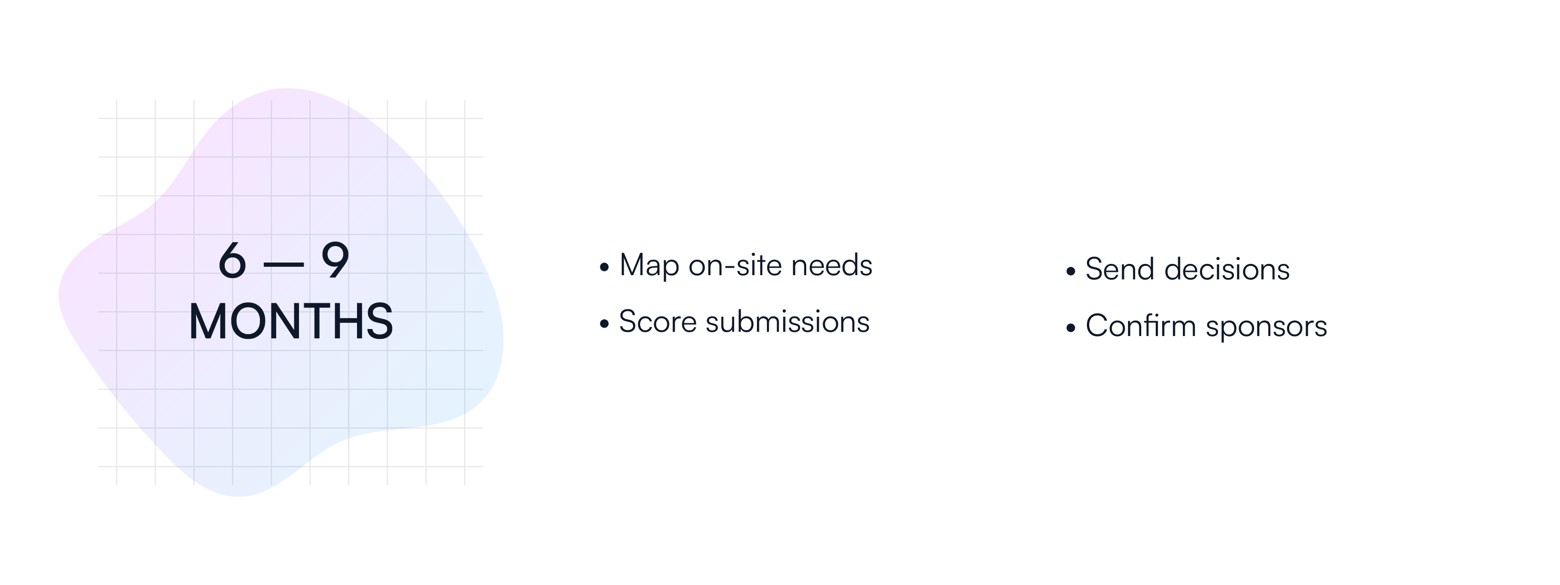
Many things get completed during the 6 to 9 months before an academic conference. Below are some things you should consider.
Start the On-Site Planning
Whether your event is in-person, hybrid, or virtual, effective venue and logistics planning is essential. Begin by determining how many rooms you'll need each day and what materials are required. Think through the arrangement of breakout rooms, which can be used for intimate discussions, poster sessions, workshops, or smaller presentations. Ensure each room is equipped with the appropriate AV and technical setup, and conduct dry runs to avoid equipment issues during the event.
Don’t forget to plan for exhibitor space if sponsors or partners will be showcasing their products or services. Make sure the area is accessible, clearly marked, and equipped with the necessary amenities.
You should also start selecting catering providers and finalize the locations for any planned social activities.
Review and Accept Submissions
Equally important is establishing a peer-review process. This is the foundation of any academic conference, guaranteeing that only high-quality submissions are included. Work with the program committee to develop a set of criteria to guide reviewers, focusing on aspects such as originality, relevance to the conference theme, and methodological rigor.
Once the submission period has ended, the review process begins. Coordinating peer reviews involves communicating clearly with both reviewers and authors. Reviewers must understand the criteria and expectations so that authors receive constructive feedback.
Notify Presenters
After reviewing the submissions, the conference committee must notify authors of their decisions. This includes informing them about whether their abstracts or papers have been accepted, rejected, or require revisions. Clear and respectful communication is vital, as it influences each author's experience with the conference and helps maintain a positive relationship with your peers.
Finalize Sponsorship and Exhibitor Agreements
As the conference nears, finalize sponsorship agreements and confirm exhibitor participation.
Think about exhibitor booth setups and promotional opportunities. You'll want to make sure that each exhibitor has a dedicated space that suits their needs, whether it’s for a display, product demonstration, or meeting. If exhibitors have not yet purchased promotional opportunities from your exhibitor kit, have your team contact them and reiterate the advantages of marketing to attendees.
3-6 Months: The Devil Is in the Logistical Details
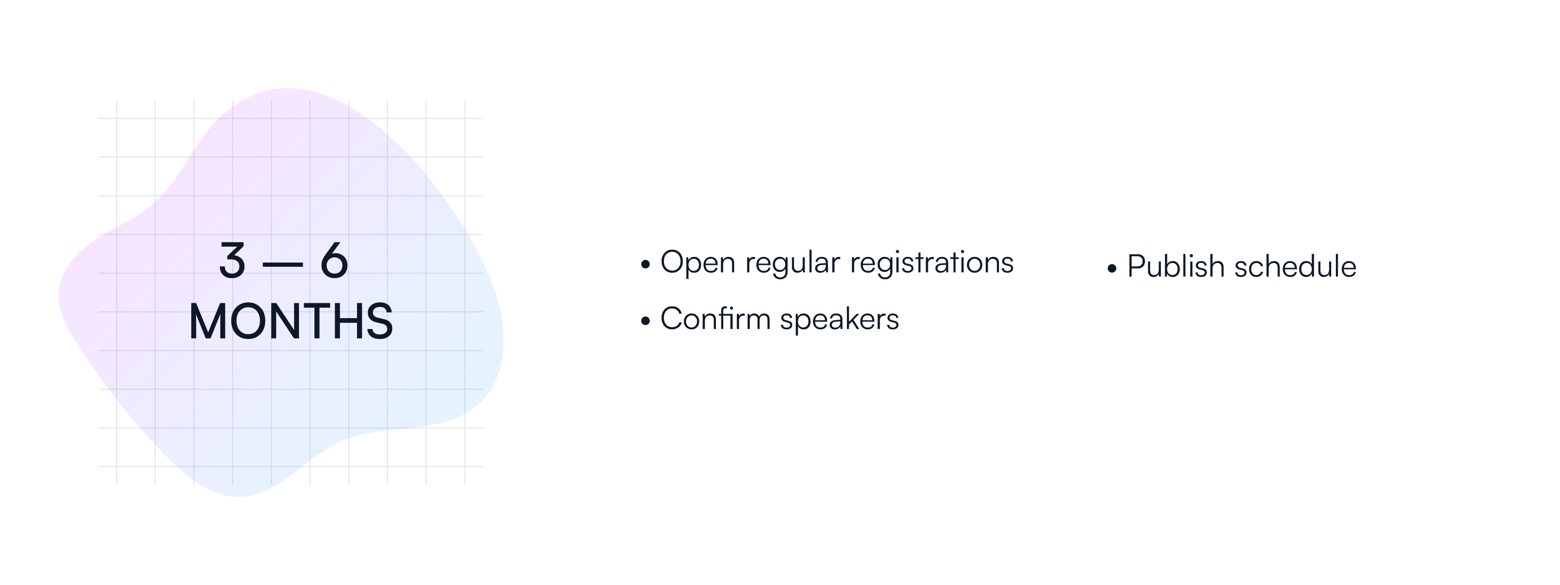
Open Regular Registration
Now that presenters have had the chance to register for the early-bird rate, it's time to open the regular registration. Continue on promoting the conference on social media and in your other previously identified channels of communication.
Prepare the Conference Schedule
With the submissions finalized and the presenters registered, you can now start organizing the conference schedule. Confirming speaker availability and making travel arrangements should be a priority. Some speakers may need assistance with visas or travel grants, so beginning these processes early will enable you to avoid any last-minute issues.
The conference schedule should be structured to allow for a balance between keynote talks, student presentations, industry expert talks and networking events like poster sessions. Keynote talks typically set the tone for the conference and should be spread across key moments of the event.
Parallel sessions allow for deep dives into various topics while maintaining a clear connection to the central conference theme. On-site poster presentations offer a more interactive experience, and these should be scheduled to encourage attendee engagement.
Consider including roundtables, panel discussions and Q&A opportunities.
If your event will be virtual or hybrid, think about which sessions will be livestreamed and allocate time for virtual poster sessions to make it more fun and engaging for the virtual attendance.
Confirm Keynote Speakers and Session Chairs
Finalize the keynote speakers and session chairs to secure the event schedule. Prioritize confirming travel and accommodation arrangements for your speakers early on to manage any logistical challenges well before the event. Provide speakers with all necessary session information, including timing, format, and technology requirements.
Finally, approve session chairs for parallel sessions. Session chairs will maintain the structure of the conference, facilitate discussions, and keep the presentations on time. Ensuring your chairs are well-briefed and prepared will make each session more enjoyable for attendees.
0-3 Months: The Final Countdown
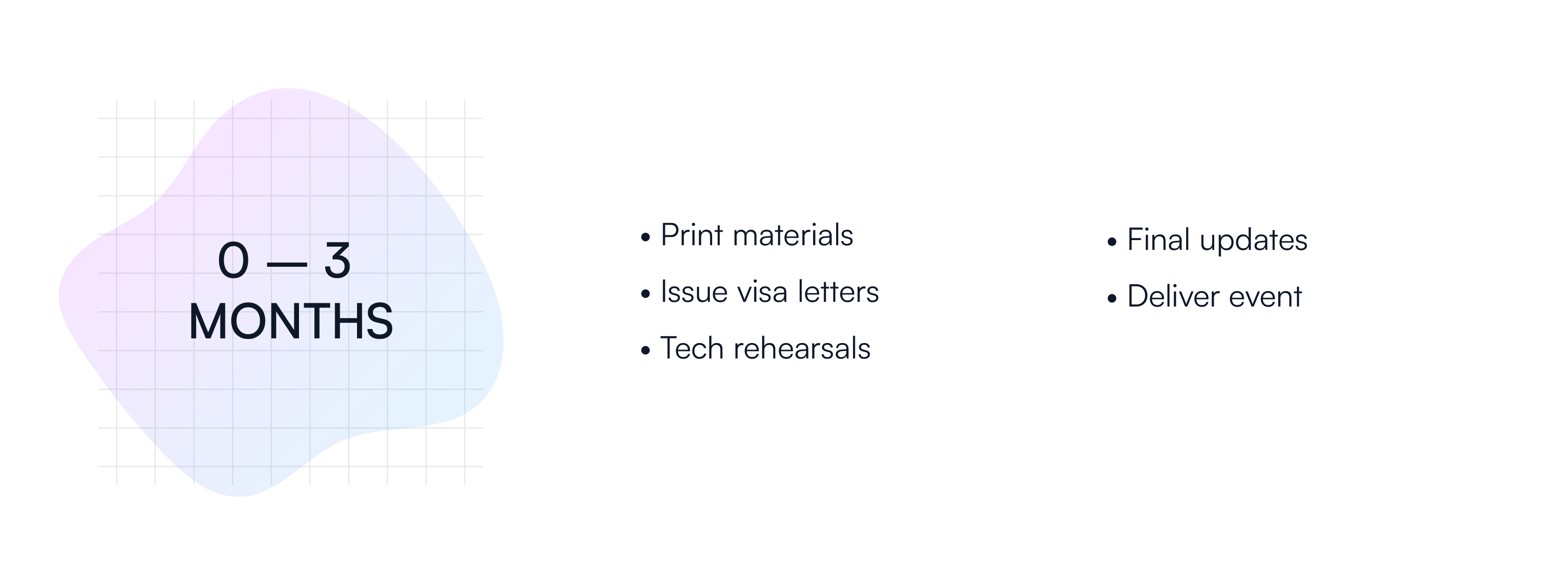
Prepare the Conference Materials
In these final months before the event, you should prepare all conference materials for both in-person and virtual attendees. Printed materials must be finalized to include on-site venue details, wi-fi access, transportation information and digital content, such as brochures and presentation materials, should be uploaded to the event website platform.
Depending on the type of academic event you are organizing, here is a list of potential conference materials you will need to prepare:
- Name badges
- Signage and banners
- Program leaflet
- Sponsorship material
- Presentation templates
- Check-in app and printed registration lists
- Any material promised for exhibitors
- Material for poster sessions
- Material for galas and receptions
- Awards and prizes
- Email newsletters
- Social media material
- Post-conference surveys
- Etc.
Finalize Travel Grants and Visa letters
Finalizing travel grants for international participants and confirming accommodation arrangements is usually conducted at this time. Provide extensive guidance on visa letters and travel details for those coming from abroad.
Rehearse the On-Site Logistics
On-site logistics can make (or break) a conference experience. By implementing digital check-in you will eliminate bottlenecks, making the entire process faster and more efficient for your attendees. Collaborate with your PCO or venue event management team; they have handled many events and will provide invaluable support in nailing down what’s left to do logistics-wise.
You’ll also need to run final tech checks to make certain that your hybrid and virtual presentations will run smoothly. Confirm that all speakers and session chairs are available and ready for their respective sessions.
Do you have any last-minute changes? Again, contact your PCO or event planning team to address them promptly.
Communicate Important Details to Attendees
Being caught up in the pre-event logistics, it's easy to forget about your participants. Pre-event communication should be top of mind. Send reminders with detailed schedules and any necessary instructions, for on-site and virtual participants. Provide clear guidelines for joining virtual sessions and accessing the event content.
Enjoy your Conference!
It’s showtime! The days leading up to the conference and during the conference can feel stressful. Remind yourself how important academic conferences are for your community to keep you going... and don't forget to enjoy yourself!
Post-Conference: Wrap-Up and Future Planning
Once your academic conference is over, send thank-you emails to speakers, sponsors, and attendees. Gathering feedback through surveys can provide great insights for improving future events.
Publishing the conference proceedings and key highlights will give attendees access to the content post-event, even those who couldn’t attend in person. Recorded sessions and key takeaways should be made available, especially for virtual attendees.
Looking forward, use the attendee feedback and metrics from this event to plan for future conferences. Reflect on what went well and what could be improved to ensure successful conferences in the future.
Leveraging Technology to Simplify Conference Planning
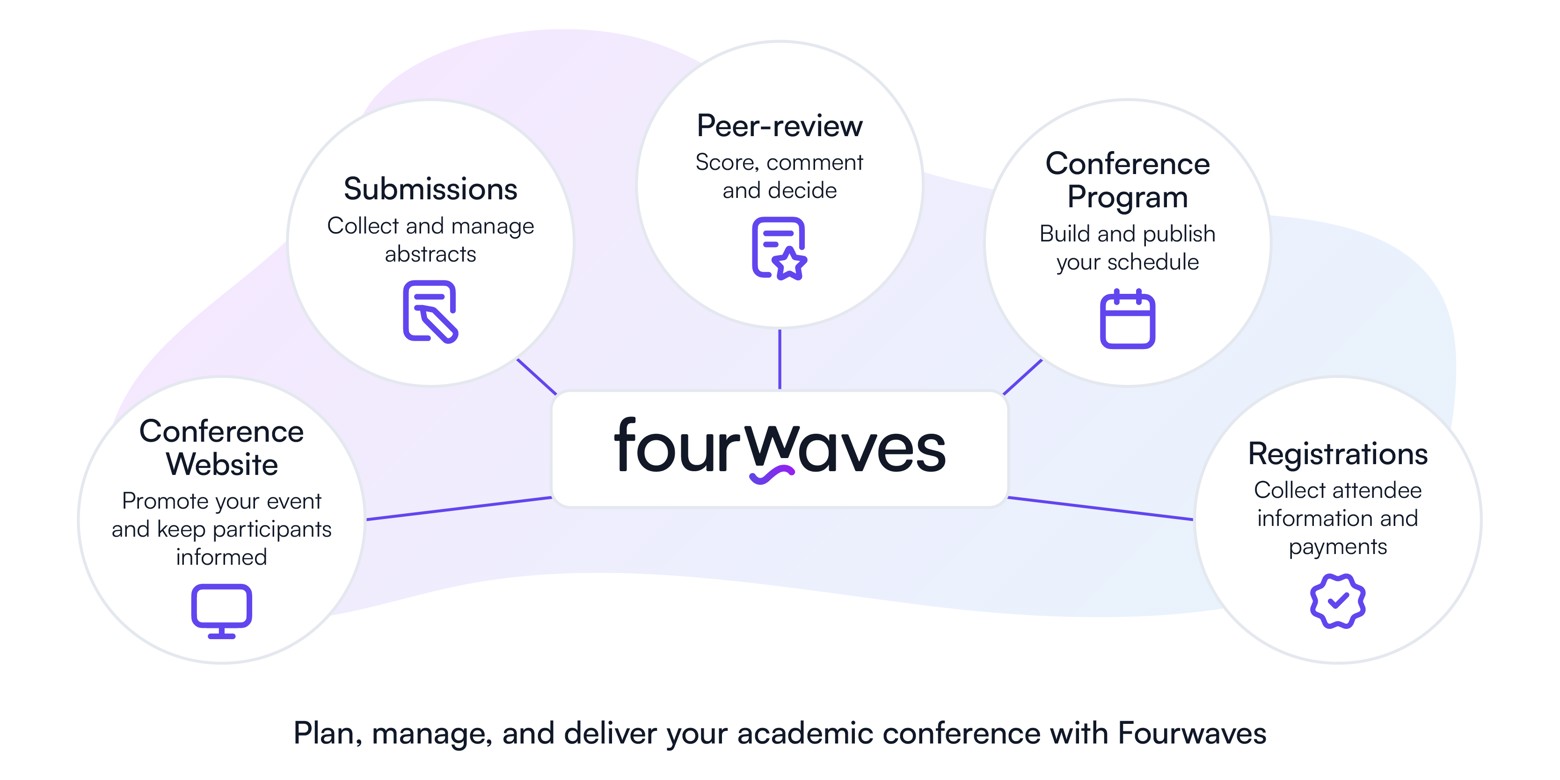
Academic conference planning can be challenging, particularly for large-scale conferences and when managing international attendees, or dealing with last-minute changes.
Leveraging technology can facilitate many of these tasks.
Platforms like Fourwaves can simplify the peer review process, abstract submission, registrations, and payment management as well as to have a beautiful conference website and app. These tools also make it easier to manage virtual components, such as poster sessions, making them indispensable for organizing a successful academic conference.
Leverage tools built for conference all seamlessly integrated together.
Conference Timeline Recap
Here's an overview of the conference timeline:
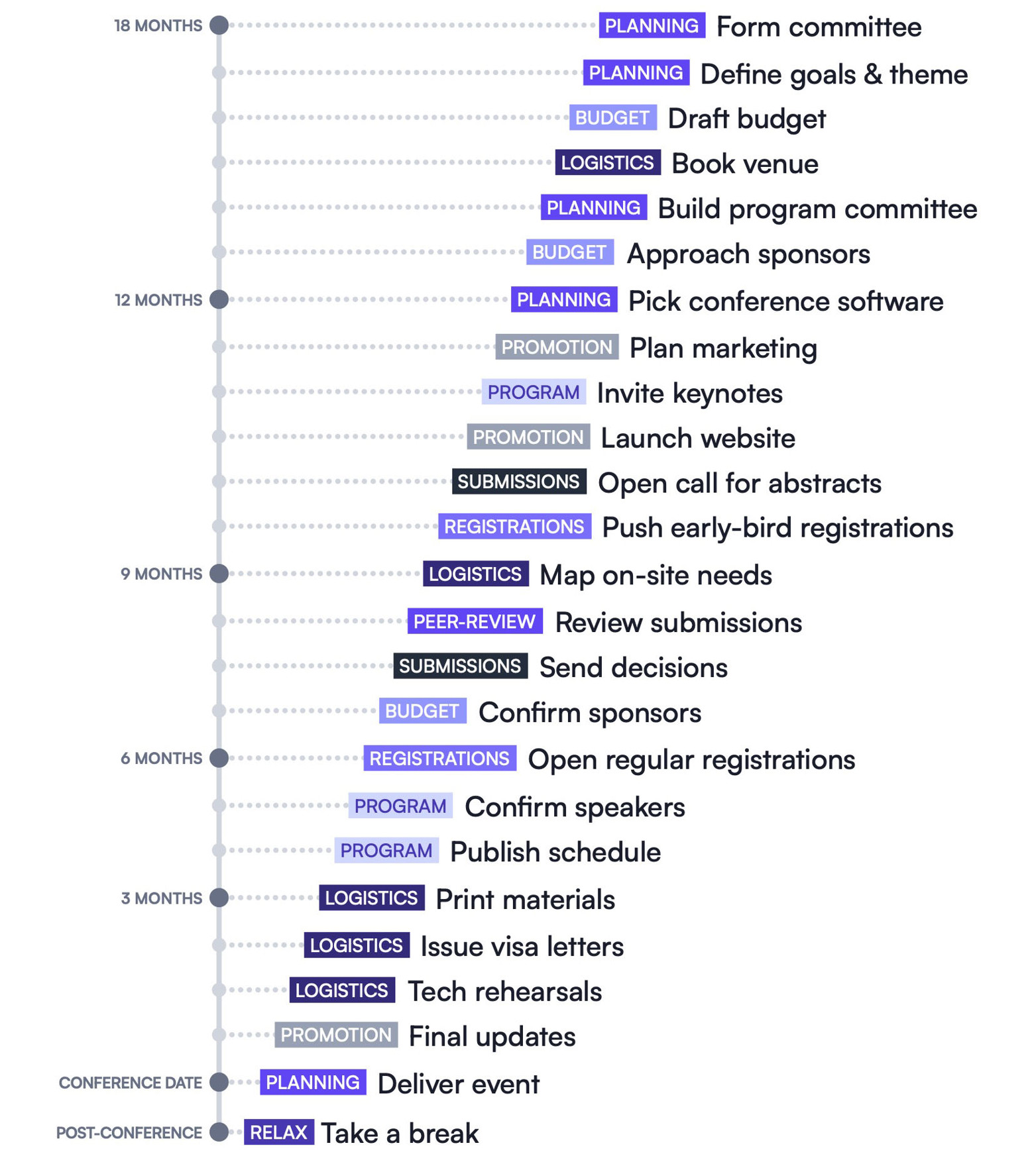
Your Conference Planning Timeline Questions Answered (FAQs)
The five stages of event planning are: conceptualization, planning, coordination, execution, and evaluation. Each stage is crucial for ensuring a successful and well-executed event.
The format depends on factors such as your target audience, budget, and the event goals. In-person events promote engagement and networking, while virtual and hybrid formats provide wider accessibility.
It’s recommended to begin planning at least 12-18 months in advance for enough time for all necessary preparations and to secure speakers, sponsors, and venues.
Planning a conference typically takes 12 to 18 months, depending on the size and complexity of the event, including logistics, programming, and promotional efforts.
Key milestones include defining conference goals, securing funding, finalizing the program, opening registration, confirming logistics, and communicating with attendees.
Use project management tools to break down tasks, set deadlines, and track progress. Focus on mission-critical tasks first, such as securing the venue and speakers, before moving to less time-sensitive tasks.


